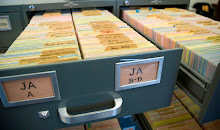
Record Content: Code
About half of all records include a code found on the upper right corner of the slip. The codes are used to track individual accession documents, letterbook documents, or diary and miscellany documents. The codes are a combination of letters and numbers. The vendor was asked to encode all of this text with <c> and we later ran an XSL transformation to parse out the distinct pieces of information. This will allow us to track the documents by their accession and letterbook numbers as well as to separately track the institutional codes for accesssioned documents.
There are four types of codes and each one is also associated with slip color: letterbook=white, accesssion=yellow, diary=pink, and miscellany=pink.
Letterbook codes all begin with "Lb" and have up to a five-digit number following it. These slips are white (<record color="3white">). They have an optional @author as well, but this is only rarely applicable:
Example:
<code type="letterbook" number="1234">Lb1234</code>
<code type="letterbook" number="21" author="JQA">JQA/Lb/21 [end]</code>
Accession codes are made up of an insitution code (where the original is housed and from whom we received a copy) and up to a six-digit number (the document tracking number). These slips are almost always yellow (<record color="2yellow">). Occasionally, an accession code is found on a blue slip. This is considered an editor error in the creation of the slip and will be reconciled later. The code should be rendered the same.
Example:
<code type="accession" repository="DNA" number="2589">DNA:2589</code>
<code type="accession" privateowner="MBSmith" number="2589">MBSmith:2589</code>
Miscellany codes are essentially shelf marks for their physical location, constructed with M for Miscellany, initials (usually JA or JQA) for the author, and a number for the volume.
Example:
<code type="miscellany" author="JA" number="78">M/JA/78</code>
Diary codes are also essentially shelf marks for their physical location, constructed with D for Diary, initials (usually JA or JQA) for the author, and a number for the volume.
Example:
<code type="diary" author="JQA" number="12">D/JQA/12</code>
General codes. Some slips, usually blue, have a code associated only with an institution but do not have a number attached because we do not have a physical copy to accession and track.
Example:
<code type="general">NN</code>

No comments:
Post a Comment